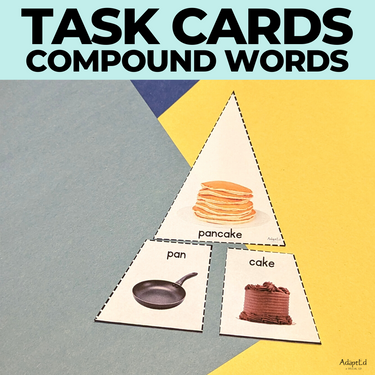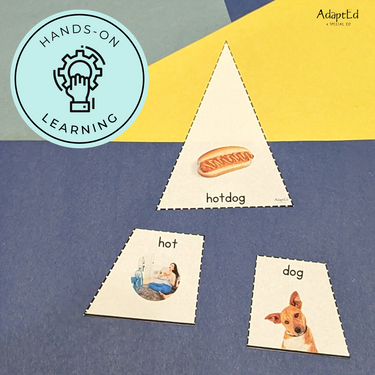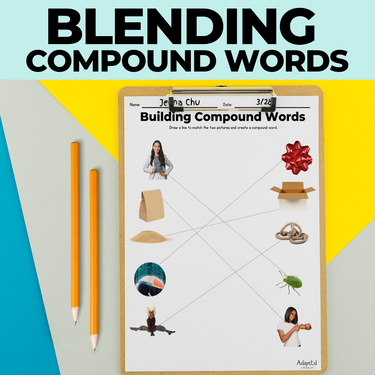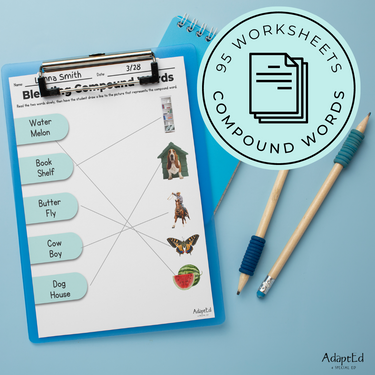Blending (4)


Compound Words Task Cards
$3.97 USD
This set is perfect for special education classrooms and beginning readers who are learning how to read. With 93 compound words included, this set is designed to help children develop their phonemic awareness skills and improve their reading abilities.
Here are some of the benefits of using compound words in special education:
Enhances Phonological Awareness: According to research, teaching compound words can enhance phonological awareness, which is an important skill for early reading development (Barton & Hargreaves, 2018). By breaking down compound words into two parts, children can learn how to identify and manipulate individual sounds in words.
Improves Vocabulary: Learning compound words can also help children improve their vocabulary skills. As they learn about word families and patterns, they can apply this knowledge to other words they encounter in their reading (Cunningham & Stanovich, 1997).
Increases Reading Fluency: When children are able to quickly recognize and decode compound words, it can increase their reading fluency. This means that they can read more smoothly and with greater comprehension (Wolf & Katzir-Cohen, 2001).
Our Building Compound Word Task Cards come in two levels - one with pictures and words and another with just pictures.
This makes it easy for teachers to differentiate instruction based on the needs of their students. The task cards are also versatile and can be used in a variety of ways such as centers, small group instruction or independent practice.
Don't miss out on this must-have resource for your special education classroom!
Order your set of Building Compound Word Task Cards today!
Sources: Barton, D., & Hargreaves, L. (2018). Teaching early reading: Principles and evidence. Sage. Cunningham, A. E., & Stanovich, K. E. (1997).
Early reading acquisition and its relation to reading experience and ability 10 years later. Developmental Psychology, 33(6), 934–945. Wolf M., & Katzir-Cohen T.(2001)
Reading fluency and its intervention Scientific Studies of Reading;5(3):211–39


Compound Words Writing
$1.00 USD
Breaking compound words into two parts and writing one of the words down can be helpful in teaching children how to read and write because it helps them learn about word families and patterns.
Level 1: Visual Support + Tracing
Level 2: Writing + Visual Support
Level 3: Writing
9 printable pages included (3 at each level)
This activity also encourages children to focus on the individual sounds within words, which can help them with spelling and decoding unfamiliar words.For non-verbal students and those with intellectual disabilities, learning how to read and write can be a challenge.
However, research has shown that using multisensory approaches can be effective in teaching literacy skills to these students. For example, a study by O'Connor et al.(2019) found that using visual cues such as pictures or gestures along with speech can improve literacy outcomes for students with intellectual disabilities.
In addition, breaking compound words into two parts can be helpful for students who struggle with language development or have difficulty processing information.
By focusing on individual parts of a word rather than the whole word, these students may find it easier to understand the meaning of the word and how it relates to other words.
Overall, practicing CVC words through activities such as breaking compound words into two parts can be beneficial for all early readers, including non-verbal students and those with intellectual disabilities.
It helps develop their phonemic awareness skills while also helping them learn about word families and patterns.
Sources: O'Connor, B., O'Connor, J., & Simon, E. (2019). The effects of a multisensory approach to literacy instruction on the phonological awareness skills of students with intellectual disability. Education and Training in Autism and Developmental Disabilities, 54(1), 20-31.


Blending Compound Words: 3 Levels: Phonemic Awa...
$5.97 USD
Blending compound words is an essential literacy skill for students with disabilities, which can greatly improve their understanding of phonemic and print awareness!
This set includes 95 worksheets, in 3 different styles to provide repetition with variety to help learners develop this ability to blend words.
Step 1: Read The teacher or instructor reads out the two words slowly, guiding the learner in repeating the word either in their head or out loud while combining the two words together.
Step 2: Blend After they have blended the word, they can then proudly circle the correct picture. (feature pictures include both individual words along with the blended compound word.)
Step 3: Evaluate If students find it difficult to understand how to combine sounds together, instructors should look out for patterns in their mistakes and model techniques that will help them understand how to blend sounds correctly.
With practice, learners can become more confident and motivated in recognizing patterns within written language, paving a path towards better reading development.
This is perfect for:
Literacy Centers Stations
Finished Bins or "I'm Finished" Work
Small Groups
Why Compound Words for Teaching Blending?
Learning to blend compound words is an integral part of literacy development for students with disabilities, as it can help build their language and sound fluency.
Teaching the skill of blending compound words provides the student with a foundation of skills that is necessary for higher order reading and comprehension tasks.
Blending compound words helps students develop both phonemic and print awareness, which is essential for success in decoding and encoding words.
With practice, the student can become more confident in their ability to recognize and recognize patterns within written language. In addition, teaching this skill gives students with disabilities an advantage in becoming independent readers.
5 Reasons Why You Should Incorporate Compound Words Into Your Reading Instruction
Compound words help beginning readers recognize and accurately blend individual sounds.
When exposed to compound words in the early stages of learning to read, students are more likely to develop strong foundational literacy skills.
Compound words provide visual cues for the learner which makes it easier for them to understand how a word is constructed and each sound pronounced.
Mastering the task of blending longer compounds words gives early readers a sense of accomplishment while learning to read.
Learning how to identify and decompose compound words in can help students memorize vocabulary better and improve spelling accuracy.


Cut and Paste Blending Compound Words: Phonemic...
$4.97 USD
Unlock the power of compound words with this 70-page collection of printable cut-and-paste compound word worksheets!
This fun, engaging resource is designed to boost your students' phonemic awareness and blending skills.
With step-by-step instructions and plenty of practice opportunities, these worksheets are perfect for both teachers and parents alike!
Here's what this amazing resource has to offer:
Improved phonemic awareness and blending skills
Breaking down longer words into smaller chunks for better understanding and processing
Improved reading, listening, and speaking comprehension
Development of vocabulary meaning with direct practice activities
Engaging activities to make learning fun and enjoyable
Step-by-step instructions for easy use
Easy customization to fit individual needs
Perfect for both teachers and parents alike to use with kids
Printable worksheets provide a convenient way to learn
This is perfect for:
Literacy Centers Stations
Finished Bins or "I'm Finished" Work
Small Groups
According to Dr. Karen Erikson a leading expert of learning disabilities, and literacy instruction. "Compound words can be used to teach phonemic awareness and early blending skills to young readers.
This helps children learn how words are constructed from the smallest phonemes combined to make a word with meaning." [1]
Sample IEP Goals:
(Student name) will use prompting and visual support to read 10 unfamiliar compound words correctly within 5 minutes by (date).
(Student name) will correctly blend 10 compound words into whole word forms, using prompting and visual support if needed, at least 70% of the time within 5 minutes by (date).
Sources
[1] Erikson, K. (2015). How Compound Words Can Help Early Readers Blending Skills. Retrieved June 26th 2019 from https://www.readinghorizons.com/blog/how-compound-words-can-help-early-readers-blending-skills
SPED EXPERTS
Materials Designed By Special Education Experts: Teacher, SLP, OTTrusted By Educators
Supporting Over 40,768+ ClassroomsInstant Access
Digital downloads are delivered immediately upon purchaseQuestions?
We're here to help
We're here to help
If you have any questions or concerns please reach out.
krystie@adapted4specialed.com
714-598-9550
Payment Methods
